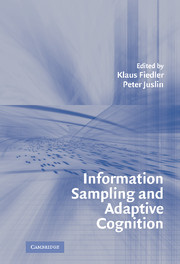Book contents
- Frontmatter
- Contents
- List of Contributors
- PART I INTRODUCTION
- PART II THE PSYCHOLOGICAL LAW OF LARGE NUMBERS
- PART III BIASED AND UNBIASED JUDGMENTS FROM BIASED SAMPLES
- PART IV WHAT INFORMATION CONTENTS ARE SAMPLED?
- PART V VICISSITUDES OF SAMPLING IN THE RESEARCHER'S MIND AND METHOD
- 16 Which World Should Be Represented in Representative Design?
- 17 “I'm m/n Confident That I'm Correct”: Confidence in Foresight and Hindsight as a Sampling Probability
- 18 Natural Sampling of Stimuli in (Artificial) Grammar Learning
- 19 Is Confidence in Decisions Related to Feedback? Evidence from Random Samples of Real-World Behavior
- Index
- References
17 - “I'm m/n Confident That I'm Correct”: Confidence in Foresight and Hindsight as a Sampling Probability
Published online by Cambridge University Press: 02 February 2010
- Frontmatter
- Contents
- List of Contributors
- PART I INTRODUCTION
- PART II THE PSYCHOLOGICAL LAW OF LARGE NUMBERS
- PART III BIASED AND UNBIASED JUDGMENTS FROM BIASED SAMPLES
- PART IV WHAT INFORMATION CONTENTS ARE SAMPLED?
- PART V VICISSITUDES OF SAMPLING IN THE RESEARCHER'S MIND AND METHOD
- 16 Which World Should Be Represented in Representative Design?
- 17 “I'm m/n Confident That I'm Correct”: Confidence in Foresight and Hindsight as a Sampling Probability
- 18 Natural Sampling of Stimuli in (Artificial) Grammar Learning
- 19 Is Confidence in Decisions Related to Feedback? Evidence from Random Samples of Real-World Behavior
- Index
- References
Summary
Occasionally the development of a scientific discipline recapitulates the trajectory of individual development from novice to expert and, particularly, that the early stages of a science coincides with the current naïve or novice understanding of phenomena. For example, people's lay theories of physical phenomena recapitulate many of the conceptions that characterized Aristotelian physics (McCloskey, 1983). Likewise, the animistic metaphysics of prescientific “primitive cultures,” attributing spirits and subjectlike qualities to (what are today considered) inanimate objects like stones and trees, is recapitulated in the young child's understanding of the environment (Piaget, 1951).
The early development of probability theory was largely linked to the classical (m/n) definition of probability: The probability of an event equals the ratio between the number m of favorable outcomes relative to the number n of equally possible outcomes (Hacking, 1975). Although frequency and degree of belief were separate aspects, for a long time they were considered two associated and relatively unproblematic sides of the same basic probability concept. Since then classical probability has been replaced by the two competing schools of frequentists and subjectivists (Hacking, 1975; Oaks, 1986). Whereas relative frequencies naturally preserve the extensional properties that originally constrained the development of probability theory, such as subset–set inclusions and the property of being a real number in the interval [0, 1], the interpretation as a subjective degree of belief is premised on the assumption (or hope) that the judge's beliefs conform to these extensional rules (Savage, 1954).
- Type
- Chapter
- Information
- Information Sampling and Adaptive Cognition , pp. 409 - 439Publisher: Cambridge University PressPrint publication year: 2005
References
- 3
- Cited by



